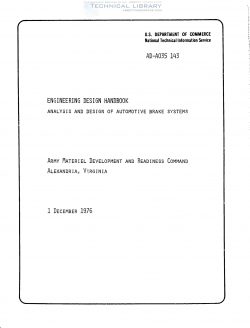DARCOM-P-706-358
- Version
- 214 Downloads
- 16.31 MB File Size
- 1 File Count
- March 5, 2017 Create Date
- March 5, 2017 Last Updated
Engineering Design Handbook - Analysis and Design of Automotive Brake Systems

CHAPTER 1 INTRODUCTION In this chapter some basic relationships are presented that show how stopping distance is dependent upon speed, deceleration, and time. The concept of tire-road friction utilization is introduced briefly. Significant problems of braking are im•roduced. Methods for improving braking perfomtance are reviewed briefly.
The vehicle is connected to the roadway by the traction forces produced by the tires. Consequently. only circumferential tire forces equal to or less than the product of normal force and tire-roadway friction coefficient can be transmitted by the wheels. Ex. ceptions are provided by special designs using aero. dynamic effects or rocket down thrusters resulting in greater normal forces On the tires than the vehicle weight. This fundamental consideration yields a possible all wheels locked minimum stopping distance Sg as given by the relationship
A significant problem of braking arises as a result of dynamic load transfer induced by vehicle de- ccleration. This is especially important in the design oi vehicles wherein a significant difference in center. ol'-gravity location exists between loaded and un- loaded cases, e.g., station wagons and trucks. For example, a typical 3/4.ton pickup truck will ex#r. ience a dynamic load transfer onto the front axle Of approximately 5(X) 1b for the empty case and 1b for the loaded case for a deceleration of 16 ft/sa, The static axle load distribution, the height of the center Of gravity above the road surface, the wheel base. as well as the level Of vehicle deceleration are factors in- fluencing dynamic load transfer. The relationships for determining the dynamic axle loads for a variety of vehicles are presented in detail in Chapters 8 and 9. For a typical two-axle tractor coupled to a single-axle trailer, commonly termed as a 2-SI combination, the dynamic axle loads as a function of vehicle de- celeration are illustrated in Fig. 1-3. These curves in. dicate that the rear axle load of the tractor is little af- fected by deceleration, whereas the front axle and the trailer axle show significant changes in their re- spective dynamic axle loads.
| File | Action |
|---|---|
| DARCOM-P-706-358 Engineering Design Handbook - Analysis and Design of Automotive Brake Systems.pdf | Download |

Comment On This Post